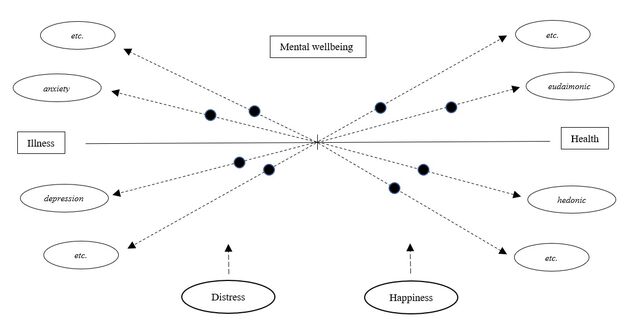Happiness
What Is Gross Domestic Wellbeing?
A new metric of societal progress to complement GDP.
Posted April 15, 2021 Reviewed by Chloe Williams
Key points
- Assessments of societal progress usually focus on Gross Domestic Product, but some argue it fails to capture what truly matters to people.
- Recent years have seen efforts to create a complementary metric, Gross Domestic Wellbeing (GDW), which describes the wellbeing of countries.
- Wellbeing is a multidimensional construct, including mental, physical, social, and spiritual dimensions.
- GDW metrics distill the multidimensional nature of wellbeing into a single score, which is reductive and imperfect but may still be useful.

How well are we doing collectively? This question has animated people throughout history, at all levels of scale (from small clans to huge empires). It has become particularly resonant over recent centuries, as narratives around societal progress took hold following the Enlightenment of the 17th and 18th centuries, becoming the defining feature of Modernity1.
In that respect, the dominant metric has been Gross Domestic Product (GDP), reflecting the total value of goods produced and services provided in a country during a given year. Often traced to the 17th century English economist William Petty, GDP came to prominence after the Bretton Woods conference in 1944, when it was selected as the main tool for measuring countries’ economies2. Since then, it has dominated international conceptions of development and progress.
However, this fixation on GDP has faced numerous critiques, not least that it fails to capture what truly matters to people. As a result, other metrics have been proposed, either to complement or replace it. Prominent among these are ones pertaining to happiness and wellbeing. Indeed, such aspirations have a long pedigree. Many Enlightenment thinkers who helped foster ideas of societal progress, such as Francis Hutcheson3, Jeremy Bentham4, and John Stuart Mill5, were keenly interested in such outcomes. They helped develop utilitarianism, a family of consequentialist ethical theories – where the ultimate arbiter of an action is its consequences, rather than abstract principles – that aim to maximize wellbeing. In Hutcheson’s words, “The best action is the one that procures the greatest happiness of the greatest numbers”6. This kind of work then informed developments like the United States Declaration of Independence, with its stated ideals of Life, Liberty and the Pursuit of Happiness.
Measuring Wellbeing
Efforts to gauge progress in such terms were hindered, however, by lack of agreed-upon or reliable measures. This issue began to change though towards the end of the 20th century, as happiness and wellbeing increasingly became topics of scientific interest, leading to the development of relevant concepts and metrics. In 1965, for instance, Hadley Cantril developed his Self-Anchoring Striving Scale, which asks respondents to consider where they currently stand on a 10-rung ladder whose base and top respectively represent the worst and best possible life imaginable7. This item is still widely used, including on the Gallup World Poll, whose data are the basis for the World Happiness Report, which since 2012 has ranked nations globally on self-reported life evaluation8.
Over subsequent decades, a wealth of scholarship has developed in this arena, with numerous interrelated concepts, which are of course much debated. One way of surveying this complex terrain is to treat wellbeing as an overarching term and to differentiate it into physical, mental, and social dimensions (as reflected in the WHO’s definition of health as “a state of complete physical, mental and social well-being, and not merely the absence of disease and infirmity”9). To this schema, some scholars also add spiritual wellbeing10. We can then introduce further nuance by viewing all dimensions as arrayed upon a spectrum between a negative and a positive pole11, and denoting the negative territory of each spectrum as illness and the positive territory as health. We can also bring happiness into the picture by viewing this concept expansively as covering the positive territory of the mental wellbeing spectrum.
The metaphor is imperfect of course: Each dimension itself could be seen as multidimensional, with any given person doing poorly on some and better on others, as illustrated here with regard to mental wellbeing. In that respect, scholars have identified different forms of happiness, of which the two main ones are hedonic (roughly, feeling good)12, and eudaimonic (roughly, character development)13. Moreover, these in turn can be differentiated further into subtypes. Hedonic happiness, for instance, is usually viewed as having a cognitive component (feeling good about life, i.e., judgements of life satisfaction)14, and an affective component (feeling good in life, i.e., positive emotions)15. Thus, it is a complex picture – and moreover, one that remains a work-in-progress – but is becoming increasingly refined, with suitable metrics developed accordingly.

Gross Domestic Wellbeing
As scholarship around wellbeing has developed, so have efforts to harness this in assessing societal development and progress. The forerunner in this regard is Bhutan, which back in 1972 replaced GDP as their gauge of societal progress with their notion of Gross National Happiness16. This is an assessment made by canvassing citizens on nine domains: psychological wellbeing; time use; community vitality; cultural diversity and resilience; ecological diversity and resilience; health; education; living standards; and good governance. Subsequently, other countries have followed their lead, albeit hesitatingly and imperfectly. The UK’s Office for National Statistics, for example, started gathering data on hedonic happiness in 2011 within its Integrated Household Survey17 – disseminated annually to 200,000 people – to create a National Well-Being Index18.
Furthermore, such developments have generated initiatives to create a metric of Gross Domestic Wellbeing (GDW) that might complement or even supplant GDP. In the UK in 2014, for instance, the then Cabinet Secretary Gus O’Donnell wrote about the value of developing such a measure19. Subsequently, The Carnegie Trust has pioneered the creation of just such a GDW score20, an initiative recognized in 2020 by the UK parliament21. This is calculated by aggregating 10 different wellbeing-related indicators (assessed by the Office of National Statistics): personal wellbeing; relationships; health; work and other activities; living situation; personal finances; the economy; education and skills; governance; and the environment. Similarly, in Japan in 2019, the Cabinet Office created a dashboard of relevant indicators, including: household finances and assets; employment environment and wages; housing; work and life (work-life balance); health; educational level and environment; social connections; natural environment; personal safety; ease of raising children; and ease of care.
As one can see, these frameworks are much broader than assessments focusing on a single metric. The World Happiness Report, for instance, has done pioneering and influential work in analyzing the happiness of nations and highlighting the importance of happiness generally. However, its rankings are based upon the single item of life evaluation, which could be regarded as just one aspect of hedonic happiness, which is only one form of happiness, which is only one facet of wellbeing. That said, the item does nevertheless invite respondents to reflect on their wellbeing as a whole. As such, the item is well-chosen: If you could only pick one question to ask people about wellbeing, that is probably the best one. However, wellbeing has yet many other aspects, and these would ideally be assessed too where possible. Moreover, the GDW metric, such as the Carnegie Trust’s formula, then condenses this complexity into a single score.
Of course, people may object that distilling the vast complexity of even one person’s wellbeing – let alone a whole nation's – into a single figure is a reductive over-simplification, which of course is true. But the question still remains: When thinking about societal progress, are we nevertheless better off trying to include a simple GDW metric (even with all its imperfections), rather than relying on GDP alone (as we currently do)? Many people would argue yes. There are other critiques of GDW besides this, of course; some people might view the notion of progress itself as flawed or even a myth. But in that case, assessing GDW is arguably even more relevant: If collective wellbeing is static or even falling, that too is important information.
Future Directions
Efforts towards creating a widely adopted GDW metric remain a work in progress. Besides work like that of the Carnegie Trust, comparable initiatives are unfolding across the globe. Another such example involves the Global Wellbeing Initiative (GWI), a partnership between Gallup and Wellbeing for Planet Earth (a Japanese research and policy foundation).
Part of the GWI's mission is developing items for the Gallup World Poll that reflect non-Western perspectives on wellbeing (responding to the critique that established measures of wellbeing, such as life satisfaction, could be deemed Western-centric, as could psychology in general22). Then, building on these efforts, the GWI and Gallup have partnered with Nikkei and other Japanese companies to provide quarterly measurements of wellbeing in Japan from 2021 onwards (reflecting the need to assess wellbeing more frequently, since annual measurements cannot detect dynamic fluctuations within any given year). It is then hoped that this survey will provide an assessment of Japanese GDW, which in turn may help shape policy.
Of course, we are some way off from having a universally recognized and widely used metric of GDW. With the introduction of any new scientific concept, there is usually first a phase of expansion (as scholars offer various versions and interpretations), followed by consolidation (where people coalesce around versions that seem particularly useful or generative). Thus, the notion of GDW is still so new that, in addition to pioneering versions like that of the Carnegie Trust and the Nikkei initiative, we are likely to see other comparable frameworks being offered and introduced. But, as these ideas are disseminated, through dialogue and collaboration, it is likely that stakeholders will coalesce around, and ideally help develop and refine, one particular version. If this then gets taken up by governments and international organizations, we may see GDW truly become a key tool in helping to improve the lives of people around the globe.
References
[1] Tarnas, R. (2010). The Passion of the Western Mind: Understanding the Ideas that have Shaped our World View. London: Random House.
[2] Dickinson, E. (2011). GDP: A brief history. Foreign Policy.
[3] Hutcheson, F. (2002). The original of our ideas of beauty and virtue. In Moral Philosophy from Montaigne to Kant, edited by J. B. Schneewind, 365-86. Cambridge: Cambridge University Press.
[4] Bentham, J. (1996). The Collected Works of Jeremy Bentham: An Introduction to the Principles of Morals and Legislation. Oxford: Clarendon Press.
[5] Mill, J. S. (1998). On Liberty and Other Essays. Oxford: Oxford University Press.
[6] The original of our ideas of beauty and virtue. In Moral Philosophy from Montaigne to Kant, edited by J. B. Schneewind, 365-86. Cambridge: Cambridge University Press.
[7] Cantril, H. (1965). The Pattern of Human Concerns. New Brunswick, NJ: Rutgers University Press.
[8] Helliwell, J. F., Layard, R., Sachs, J. D., & De Neve,J.-E. (2021). World Happiness Report 2021. New York: Sustainable Development Solutions Network.
[9] World Health Organization (1948). Preamble to the Constitution of the World Health Organization as Adopted by the International Health Conference, New York, 19-22 June, 1946. Geneva: World Health Organization.
[10] VanderWeele, T. J., Long, K., & Balboni, M. J. (2021). On tradition-specific measures of spiritual wellbeing. In Measuring Wellbeing: Interdisciplinary Perspectives from the Social Sciences and the Humanities, edited by M. Lee, L. D. Kubzansky, & T. J. VanderWeele, Measuring Wellbeing: Interdisciplinary Perspectives from the Social Sciences and the Humanities. Oxford: Oxford University Press.
[11] Keyes, C. L. M. (2007). Promoting and protecting mental health as flourishing: A complementary strategy for improving national mental health. American Psychologist, 62, 95–108.
[12] Diener, E. (2009). Assessing Well-Being: The Collected Works of Ed Diener. New York: Springer.
[13] Ryff, C. D. (1989). Happiness is everything, or is it? Explorations on the meaning of psychological well-being. Journal of personality and social psychology 57(6): 1069-1081.
[14] Diener, E., Emmons, R. A., Larsen, R. J., & Griffin, S. (1985). The satisfaction with life scale. Journal of Personality Assessment 49(1): 71-75.
[15] Watson, D., Clark, A. L., & Tellegen, A. (1988). Development and validation of brief measures of positive and negative affect: The PANAS Scales. Journal of Personality and Social Psychology 47: 1063–1070.
[16] Braun, A. A. (2009). Gross National Happiness in Bhutan: A living example of an alternative approach to progress.” Social Impact Research Experience Journal (Sire) 1: 1-142. at: http://repository.upenn.edu/sire
[17] Office for National Statistics (2011). Initial Investigation into Subjective Well-being from the Opinions Survey. London: Office for National Statistics.
[18] Everett, G. (2015). Measuring national well-being: A UK perspective. Review of Income and Wealth, 61(1): 34-42.
[19] O’Donnell, G. (2014). Gross Domestic Wellbeing. Project Syndicate.
[20] Wallace, J., Ormston, H., Thurman, B., Diffley, M., McFarlane, M., & Zubairi, S. (2020). Gross Domestic Wellbeing (GDWe): An alternative measure of social progress. Fife: Carnegie UK Trust.
[21] Gross Domestic Wellbeing. Early Day Motion tabled on 3rd December 2020. https://edm.parliament.uk/early-day-motion/57830/gross-domestic-wellbei…
[22] Henrich, J., Heine, S. J., & Norenzayan, A. (2010). Most people are not WEIRD. Nature, 466, 29.




